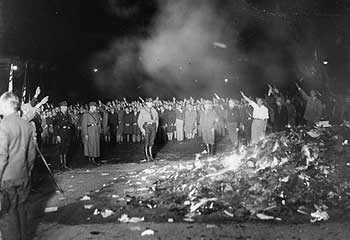 The recent controversy over burning the Koran in Florida on the anniversary of the September 11 attacks on the United States made headlines worldwide. Over 65 years ago, the world watched as the German people under Nazi rule burned thousands of books in massive bonfires fueled by copies of books from authors they deemed undesirable. Of course, this was not the first time that books were the fuel for fires around the world. Books were burned in 221 B.C. by the Chinese, and Martin Luther burned books of canon law along with a papal bull against him in the 16th century. In 1817, German students celebrated Martin Luther burning books by burning more books that they felt were unacceptable and contrary to the national spirit and character. (Ritchie 1988)
The recent controversy over burning the Koran in Florida on the anniversary of the September 11 attacks on the United States made headlines worldwide. Over 65 years ago, the world watched as the German people under Nazi rule burned thousands of books in massive bonfires fueled by copies of books from authors they deemed undesirable. Of course, this was not the first time that books were the fuel for fires around the world. Books were burned in 221 B.C. by the Chinese, and Martin Luther burned books of canon law along with a papal bull against him in the 16th century. In 1817, German students celebrated Martin Luther burning books by burning more books that they felt were unacceptable and contrary to the national spirit and character. (Ritchie 1988)
A country ruled by a totalitarian regime needs to have its citizens staunchly supporting it, without dissidence for it to succeed. The Nazi party used the economic crisis facing the country after World War I, and propaganda aimed at fanning the flames of nationalism to rise to power legally. To maintain its extreme worldviews, the Nazi party sought to eliminate any person, or thought that would conflict with its mission. By motivating the college age population to burn thousands of books, the German Student Association was able to align itself to the Nazi ideal. Joseph Goebbels, the Nazi propaganda minister, spoke on the May 10, 1933 beginning of the book burning, as much of the books burned were written by Jewish authors. One has to remember that the Nazi party had courted the youth closely, and that many of the then current college students were involved with the Nazi party in various forms prior to enrolling in college.
After the Reichstag fire, which burned an important government building in Berlin, similar to the current U.S. Capitol building in importance, the Nazi party unleashed a fierce assault on every group they found to be undesirable. With the vast majority of the nation supporting them, and rallying together after a national building had been torched, they found it easy to criticize Communists, homosexuals, Jews, Jehovah’s Witnesses, trade unionists, and many intellectuals. Further, many leading liberal authors came under fire and as persecution worsened, many left the country permanently. Even Einstein left under persecution from the rising Nazi party. The Nazis sought to infiltrate all professional bodies that worked with writers, to force any communists, or Jewish writers to leave. The Congress of the Free Word, a conference for authors and intellectuals was broken up by police on February 18, 1933, and the police stood by as the Nazis assaulted any in the crowd they wanted to. As the Nazis replaced professors, curators, teachers, librarians and other educational personal with people who believed the way they did, and reflected their ideals in their appearance, all schools, from elementary to university, stopped the free flow of ideas and information, and became centers of propaganda for the Nazis.
Leading up to the burning of books, dozens of college towns throughout the country of Germany were to have torch lit parades, with students, professors, and Nazi officials attending, participating, and speaking to the thousands gathered to witness the spectacle. Many thousands gathered to hear Goebbels speak on the occasion, and others heard everything on the radio broadcasts. It was dubbed, “Action against the Un-German Spirit” and it was a resounding success in the eyes of the Nazis. American authors like Jack London, Ernest Hemingway, and Helen Keller were burned, and H.G. Wells, a British author had his books torched. Of course, many Jewish authors were burned, and Karl Marx, who was born in Germany, but the mind behind the communist ideal, had his books burned as well.
Less than 15 years later, in 1946 the German people and remnants of the Nazi party would it felt like to be censored as the millions of books distributed by the Nazi party were burned. Schoolbooks for children of all ages, documents, propaganda, fictional novels, films, poetry, and anything else that could be deemed as contributing to militarism or Nazism were to be destroyed. The Allies goal of Denazification, or rooting out all Nazism in Germany, made possessing any literature or media of the Third Reich against the law. While many defended the measure, some felt that any censorship was wrong, and that by banning the different Nazi media, it would become more popular, and portray the fallen totalitarian government as a martyr. (Germany: Read No Evil 1946)
References
Bunker, Lisa, and Bonnie Travers. When Books Burn: Introduction. February 19, 2002. http://www.library.arizona.edu/images/burnedbooks/intro.htm (accessed September 28, 2010).
Institute for Advanced Study. In Brief. 2005. http://www.ias.edu/people/einstein/in-brief (accessed September 28, 2010).
LeMaster, Lynne. Fighting the Fires of Hate: America and the Nazi Book Burnings. May 4, 2008. http://www.prescottenews.com/community/yavapai-county/fighting-the-fires-of-hate-america-and-the-nazi-book-burnings (accessed September 28, 2010).
Ritchie, J. M. “The Nazi Book-Burning.” The Modern Language Review, July 1988: 627-643.
Time. “Germany: Read No Evil.” May 27, 1946.
United States Holocaust Museum. Bibliographies. April 1, 2010. http://www.ushmm.org/wlc/en/article.php?ModuleId=10005852 (accessed September 28, 2010).
—. Book Burning. April 1, 2010. http://www.ushmm.org/wlc/en/article.php?ModuleId=10005852 (accessed September 28, 2010).